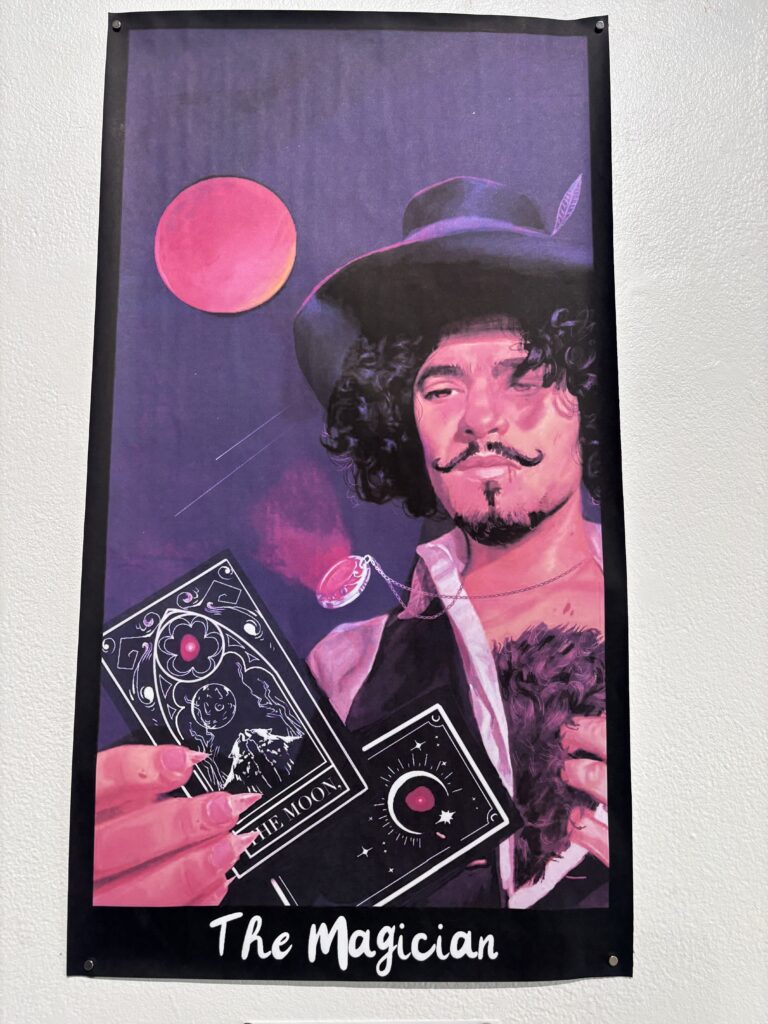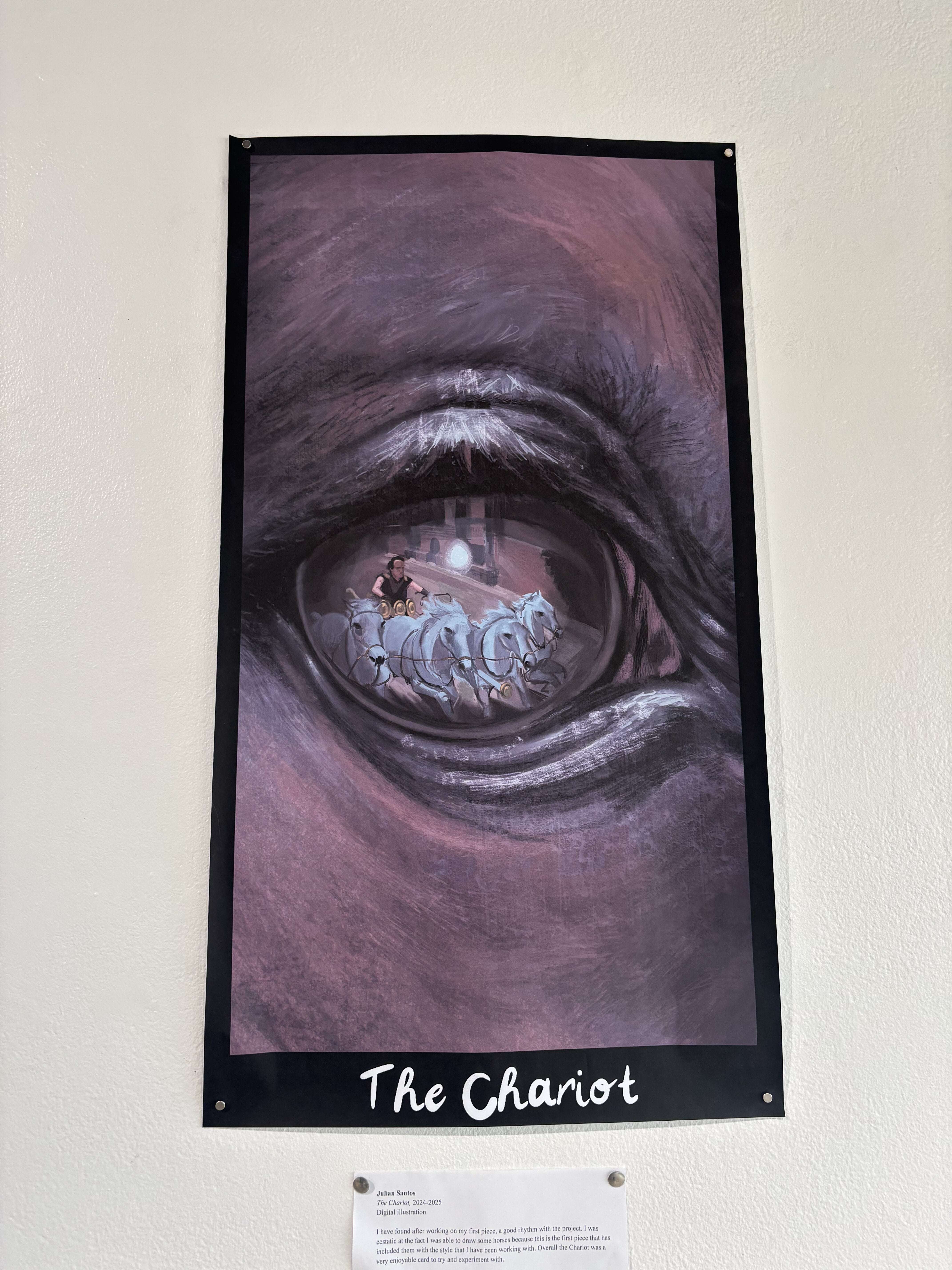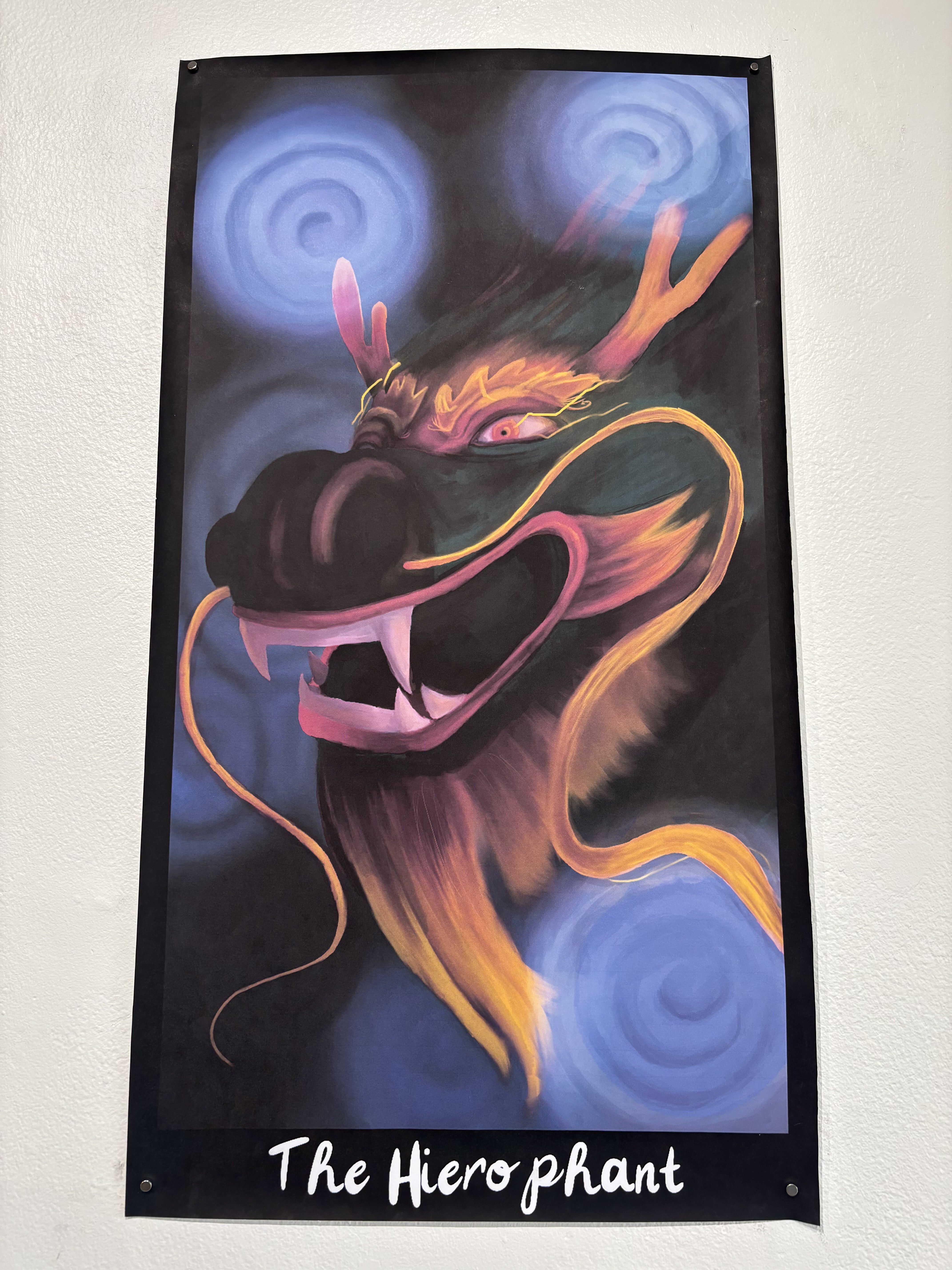MAISIE STRADER
Special to The Leader

The Magician, by Julian Santos.
Photo by MAISIE STRADER | Special to The Leader
Warning: Depictions of violence.
All people believe different things; some believe in magic, and others do not. However, just because you can’t see it doesn’t mean it isn’t real.
Tarot readings are a controversial topic to many, but to some, they’re a fascinating look into the world of spirituality.
These readings are influenced by the shuffling of cards to predict your thoughts, feelings and future.
Students Andrea Conner, Ben Evans, Brianna Gasper, Evelyn Osborne, Em McKevitt, Isabella Weber, Jocelyn Seib, Julian Santos, Kadence Osborne, Ariel Wiechmann, Maya Kulick, Nia Anand, Natalie Weber and Ryan Turtel recently opened an artwork exhibition called ‘Myths & Magics Tarot.’
The exhibit was located in the Emmitt Christian Gallery, which was available to view from Feb. 10-26.
The students state, in the write-up titled “The Mission,” “With only the 22 Major Arcana, the 14 of us each took on one or two artworks that represented the meaning of each card and fit into the theme chosen for this project: Myths and Magics. Instead of sifting creativity, artists were encouraged to research as much as they could about their chosen cards and look at other decks. Then, when it came down to illustrating that work, each artist could take their own creative liberty with their newfound knowledge — many of which choose to take myths surrounding their tarot and breathe it new life.”
The first card in the arcana is called “The World,” which was designed by Andrea Conner. Her work is a digital illustration of a woman with brown wavy hair, wearing a flower crown, reaching into the world from the sky and pointing with her finger to create a hurricane. Conner states, “Mother Earth continues to create new stories on Earth. In her hair, you can see a wreath which represents the cycle from beginning to end to new beginnings.”
The second card represented is titled, “Judgement,” a digital media piece by Evie Osborne. Judgement is pictured as a bird-being standing on top of a pedestal ablaze, as a man begs before them. The viewer may also see smaller details such as the shadow of a hand in the dress of the bird. The artist took creative inspiration from the Egyptian God Osiris or the Phoenix from various mythologies.
The next card is labeled “The Sun,” a digital illustration by Isabella Weber. The illustration is pictured as a knight or hero, in bronze armor drawn with a red cape. The Sun is depicted as the head of the knight as he points his sword to the viewer with his other hand clenched. Weber says, “The Sun card, when pulled upward, is meant to represent vitality, self-confidence and success.”
“The Moon,” the fourth arcana card, is a digital media piece by Evie Osborne. Osborne shares, “I grew up with tales of the Puca, an Irish Shapeshifter known for its trickery, and felt it would work perfectly with The Moon’s Tarot themes of deception.” The work is shown as an image of a younger-looking boy, drawing a curtain back to find the moon, along with three wolf-like animals. Osborne uses colors such as purple and black to embrace the glow of the white moon in the middle.

The Chariot, by Julian Santos
Photo by MAISIE STRADER | Special to the Leader
The next card is “The Star,” a digital illustration by Ryan Turtel. Turtel puts a pop art theme to his, using all sorts of colors, to capture the Sun as a rockstar. He says, “The Star tarot card represents bringing hope, renewed power and strength to carry on with life. The card itself is a message to its reader to have faith, and trust in your own self-fulfillment, which I related to a lot.” The artist mentions that he took inspiration from the mythological figure, Astraeus, the titan god of the stars.
Following the order, there is “The Tower,” a digital illustration by Benjamin Evans. Evans shows a windmill that has captured a bird on the rotator blade. The bird sits there as he draws himself sitting on the tower. His pages fly around the card. Evans says, “The crow will come down one day, when all his sketches are swept away, and his grievances fade into sacred, bittersweet memories.”
One of the most popular cards is labeled “The Devil.” Student Em McKevitt says, “For my card, I wanted to focus around … this idea of overindulgence and how innocent it may seem at first.” The Devil is depicted as a red coat dressed in a black cape, spilling a red liquid from his hands, with the moon behind him.
The next card is called “Temperance,” a digital illustration by Kadence Osborne. The card is depicted as a blinded sorcerer with long hair and feminine features. She wears a long dress with an attached cape, levitating a clock in her hands. Osborne says, “When I took on this card alongside Strength, I could see how much they both played into each other. However, there was one aspect I found in Temperance that Strength didn’t quite focus on [—] time. In order to achieve peace of mind, one must be patient in the pursuit of greatness.”
Another popular card in a tarot deck is called “Death.” This card represents transformation and new beginnings. The artist Nia Anand says, “In the artwork I depicted Kali, who is the goddess of destruction in Indian Mythology, as a symbol of death.” Kali is shown in the middle of fire, dancing around three people with horns growing from their heads and bleeding on their faces.

The Hierophant, by Natalie Weber
Photo by MAISIE STRADER | Special to The Leader
The “Hanged Man” is a digital illustration by Brianna Gasper. She focused her image on a naked woman tied to a rock with rope, as a snake slithers around her. Gasper says the piece is, “An illustrated telling of the Binding of Loki from Norse mythology. The Binding of Loki is the tale of how the trickster god ran from Asgard to hide away in Midgard — the mortal realm — after he murdered the god of light, beauty and purity, Balder.”
The next card in the gallery was titled “Justice,” also by Brianna Gasper. This illustration depicts Egyptian gods at a table. Gasper writes in the caption, “An illustrated telling of the Weighing of the Heart, a ritual performed by the gods Anubis, Ma’at, and Ammit. A mortal’s heart would be weighed by Anubis, the Guardian of the Scales and god of funerary rites, upon a set of scales in the Duat or the Underworld — against a feather which represented Ma’at, the goddess of truth and justice who was responsible for maintaining order in the universe.”
The “Wheel of Fortune” card was a digital illustration given to student artist Ariel Wiechmann. The audience may see a red woman with long orange hair floating in the sky holding an astrological wheel. The signs on the wheel represent the four signs, Aquarius, Scorpio, Leo and Taurus; which represent the four elements: water, fire, air and water.
The next card is called, “The Hermit.” The artist Maya Kulick says, “The Hermit, while also finding comfort in its home, finds comfort in its own thoughts and company. The piece focuses more on the comfort of solitude that the Hermit can mean when pulled through the comforting environment and a soft color palette.” The Hermit is shown to be snuggled into bed with a long beard dipping into his mug.
Ultimately, Myths and Magics has shown this timeless vision with a new bold digital theme, offering a personable selection of artistic concepts with each person structuring their card the way they see it.
